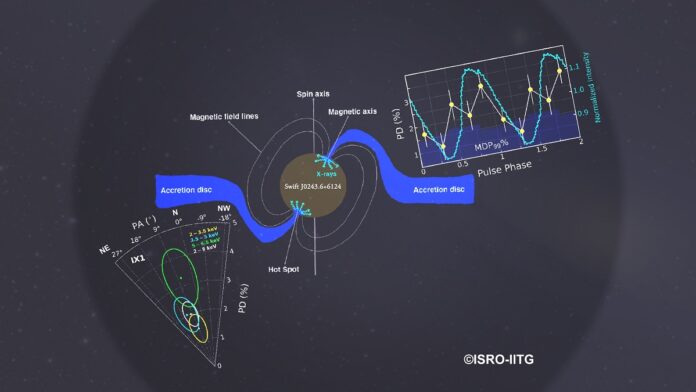Researchers from the Indian Institute of Technology (IIT) Guwahati and the Indian Space Research Organisation (ISRO) have made a groundbreaking discovery regarding the polarization of X-rays emitted by a galactic ultraluminous X-ray pulsar. This major finding, which reveals low polarization levels in the X-rays, marks an important step forward in the field of astrophysics and deepens our understanding of the nature and behavior of these enigmatic celestial bodies.
Understanding the Discovery: Low Polarization in X-Rays
The collaborative research between IIT Guwahati and ISRO focused on studying X-rays emitted by an ultraluminous X-ray (ULX) pulsar located within our galaxy. X-ray polarization is a measure of the orientation of the electromagnetic waves in X-rays and provides critical information about the conditions and processes occurring near the X-ray source. The discovery of low polarization in these X-rays is unexpected and challenges existing models that explain the high-energy emissions from such pulsars.
- Ultraluminous X-ray Pulsars: ULX pulsars are a type of neutron star that emits exceptionally bright X-rays. They are considered to be among the most luminous X-ray sources in the universe. The mechanisms behind their intense X-ray emissions are not yet fully understood, making them a subject of keen interest in astrophysical research.
- Importance of X-ray Polarization Studies: By analyzing the polarization of X-rays, researchers can gain insights into the magnetic fields, accretion processes, and the geometry of the emission regions around pulsars. Low polarization levels suggest that the magnetic field configuration or the geometry of the emitting region may differ from what is traditionally expected in such high-energy environments.
- Significance of the Findings: The discovery of low polarization levels in X-rays from the galactic ULX pulsar offers new clues about the complex physics governing these high-energy sources. It suggests that the magnetic fields around the pulsar may be more chaotic or that the emission mechanisms are more complex than previously thought. These findings open up new avenues for theoretical and observational studies on ULX pulsars.
Role of IIT Guwahati and ISRO in the Discovery
The research team from IIT Guwahati and ISRO utilized advanced observational tools and data analysis techniques to study the polarization of X-rays. ISRO’s X-ray Polarimeter Satellite (XPoSat), India’s first dedicated polarimetry mission, played a crucial role in this discovery. XPoSat is equipped with sensitive instruments capable of detecting the polarization of X-rays, providing vital data that enabled the researchers to measure the low polarization levels in the emissions from the ULX pulsar.
- IIT Guwahati’s Expertise in Data Analysis: The team from IIT Guwahati brought their expertise in astrophysical data analysis and theoretical modeling to the study. They worked on interpreting the polarization data, developing models to explain the observed low polarization levels, and understanding the implications of these findings for current theories on X-ray emissions.
- ISRO’s XPoSat Mission: ISRO’s XPoSat mission is designed to study the polarization of cosmic X-rays and contribute to our understanding of high-energy astrophysical phenomena. The data from XPoSat has been instrumental in discovering low polarization in the X-rays from the galactic ULX pulsar, showcasing India’s growing capabilities in space research and astrophysics.
Implications of the Discovery for Astrophysics
This discovery has significant implications for astrophysics, particularly in understanding the nature of X-ray emissions from ultraluminous X-ray sources. The findings challenge existing models and call for a re-evaluation of theories related to the magnetic fields and accretion processes around neutron stars.
- New Theoretical Models: The discovery of low polarization levels in the X-rays suggests that current models of ULX pulsars may need to be revised. Theoretical astrophysicists will need to consider new mechanisms or configurations of magnetic fields that could produce such low polarization levels.
- Future Observational Studies: The results encourage further observational studies to investigate X-ray polarization in other ULX pulsars and similar high-energy sources. Understanding whether low polarization is a common feature among ULX pulsars or specific to the one studied could provide deeper insights into their nature.
The collaborative discovery by IIT Guwahati and ISRO of low polarization in X-rays from a galactic ultraluminous X-ray pulsar is a milestone in astrophysical research. This finding challenges existing theories and opens up new directions for understanding the complex physics of high-energy astronomical phenomena. As research progresses, these insights will enhance our knowledge of the universe and the exotic objects it contains.




